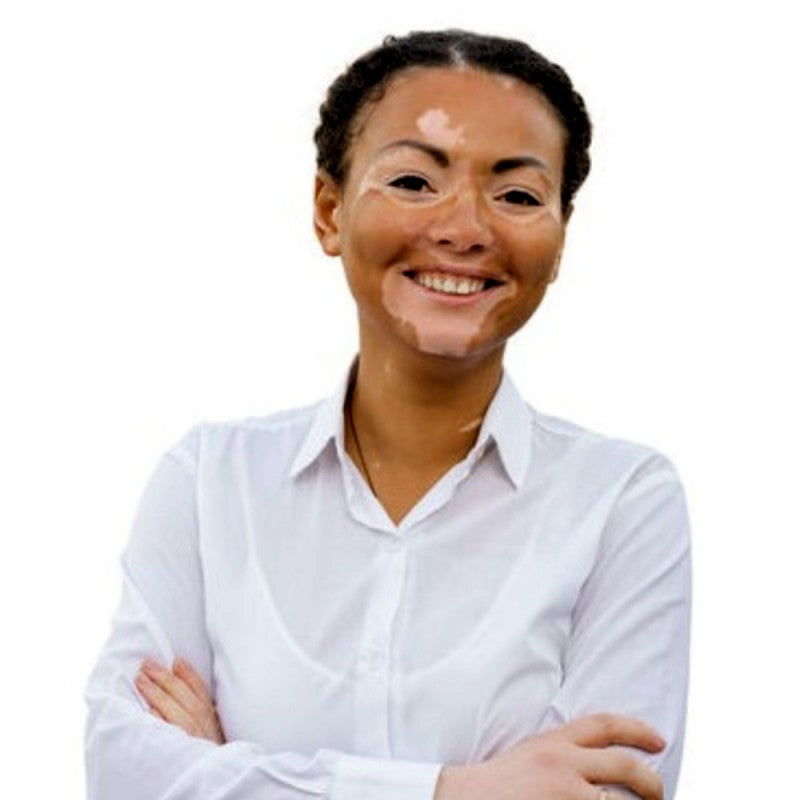
Vitiligo and Sun Exposure: What You Need to Know
Share
Vitiligo and Sun Exposure: What You Need to Know
Vitiligo is a skin condition characterized by the gradual disappearance of melanocytes, the cells responsible for melanin production. This loss leads to the appearance of white patches on the skin, which vary in size from person to person. Sun exposure plays a particular role in the development and perception of vitiligo.
Why does the sun have a particular impact on vitiligo?
Lack of melanin : Depigmented areas no longer have natural protection against UV rays. They are therefore much more vulnerable to sunburn.
Visual contrast : On tanned skin, white spots become more visible, which can accentuate the aesthetic and psychological impact of the disease.
Melanocyte stimulation : In some cases, controlled and moderate exposure to the sun can promote slight repigmentation by stimulating the remaining melanocytes. This is the principle of certain phototherapies used in dermatology.
The potential benefits of controlled exposure
Production of vitamin D , often deficient in patients who avoid the sun.
Possible improvement of certain lesions thanks to natural stimulation of melanocytes.
Positive effect on morale, often undermined by illness.
Risks not to be overlooked
Rapid and intense sunburn on depigmented areas.
Increased risk of skin cancer in case of excessive exposure without protection.
Hyperpigmentation of healthy areas, which further accentuates the contrast with the white spots.
Vitiligo and Sun Exposure: What You Need to Know
Vitiligo is a skin condition characterized by the gradual disappearance of melanocytes, the cells responsible for melanin production. This loss leads to the appearance of white patches on the skin, which vary in size from person to person. Sun exposure plays a particular role in the development and perception of vitiligo.
Why does the sun have a particular impact on vitiligo?
Lack of melanin : Depigmented areas no longer have natural protection against UV rays. They are therefore much more vulnerable to sunburn.
Visual contrast : On tanned skin, white spots become more visible, which can accentuate the aesthetic and psychological impact of the disease.
Melanocyte stimulation : In some cases, controlled and moderate exposure to the sun can promote slight repigmentation by stimulating the remaining melanocytes. This is the principle of certain phototherapies used in dermatology.
The potential benefits of controlled exposure
Production of vitamin D , often deficient in patients who avoid the sun.
Possible improvement of certain lesions thanks to natural stimulation of melanocytes.
Positive effect on morale, often undermined by illness.
Risks not to be overlooked
Rapid and intense sunburn on depigmented areas.
Increased risk of skin cancer in case of excessive exposure without protection.
Hyperpigmentation of healthy areas, which further accentuates the contrast with the white spots.
Practical advice for people with vitiligo
Use high sun protection (factor 50+) on all exposed areas, especially depigmented lesions.
Avoid prolonged exposure and seek shade during the hottest hours (11 a.m.-4 p.m.).
Favor gentle and gradual exposure , a few minutes per day, to benefit from the positive effects without danger.
Protective clothing : hat, light long sleeves, sunglasses.
Regular dermatological monitoring , in order to detect possible skin complications.
In summary
Sun exposure, for someone with vitiligo, is both an opportunity and a risk. When properly managed, it can contribute to well-being and sometimes even lead to some repigmentation. When poorly managed, it exposes people to severe sunburn and an increased risk of skin cancer. The key, therefore, remains moderation, appropriate sun protection, and regular medical support .
-
Use high sun protection (factor 50+) on all exposed areas, especially depigmented lesions.
-
Avoid prolonged exposure and seek shade during the hottest hours (11 a.m.-4 p.m.).
-
Favor gentle and gradual exposure , a few minutes per day, to benefit from the positive effects without danger.
-
Protective clothing : hat, light long sleeves, sunglasses.
-
Regular dermatological monitoring , in order to detect possible skin complications.
In summary
Sun exposure, for someone with vitiligo, is both an opportunity and a risk. When properly managed, it can contribute to well-being and sometimes even lead to some repigmentation. When poorly managed, it exposes people to severe sunburn and an increased risk of skin cancer. The key, therefore, remains moderation, appropriate sun protection, and regular medical support .
